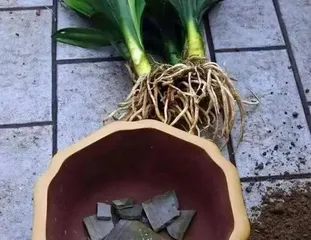Clivia is a very common and popular ornamental plant. Its beautiful flower form and jade-green leaves often bring a sense of joy and comfort to our indoor environment. To ensure the healthy growth of Clivia, in addition to paying attention to watering and fertilizing, it is also necessary to regularly prune the roots and repot the plant. However, due to the complex and well-developed root system of Clivia, many people are not very skilled when carrying out this work. This article will introduce some practical tips and suggestions for pruning the roots and repotting Clivia.

Prepare Tools
1. Prepare tools such as gardening shears, saws, and shovels.
2. Prepare new soil and a new pot.

3. Water the Clivia thoroughly to moisten its roots.
Preliminary Inspection
1. Check the growth condition of the Clivia and understand the condition of its root system.
2. Observe whether the soil is loose and if there is any waterlogging.

3. Check the condition of the pot for any cracks or signs of aging.
Preparation Before Pruning
1. Water the Clivia thoroughly to make it easier to clean the roots.
2. Turn the pot upside down and gently remove the Clivia.
3. Clean the root system, trim off old roots, and keep the healthy ones.
Pruning Methods
1. Use gardening shears or a saw to prune withered, rotten, or damaged roots.
2. Keep the normal, healthy roots; do not cut off the entire root system.
3. Be careful not to damage the plant's stem and leaves.
Cleaning the Soil
1. Clean off the old soil, removing any aged or loose soil.
2. Check if the soil is too dry and add an appropriate amount of water if needed.
3. Clean the inside of the pot and disinfect it.
Repotting Process
1. Prepare a new pot and new soil.
2. Choose a pot of the appropriate size according to the size and growth condition of the plant.
3. Transplant the plant into the new pot.
Precautions
1. After repotting, do not water immediately; let the plant rest for a while.
2. Avoid repotting in hot or cold weather.
3. The plant's growth stage and season should also be considered, as the frequency of repotting varies in different situations.
Watering and Fertilizing
1. After repotting, water an appropriate amount to moisten the soil.
2. Do not water too frequently to avoid root rot.
3. Fertilize at the appropriate time and do not over-fertilize.
Light Management
1. Clivia prefers a bright environment but avoid direct sunlight.
2. In an indoor environment, it is necessary to move the plant frequently so that all sides can receive sunlight.
Temperature Regulation
1. Clivia grows best in a warm environment, with a suitable temperature of 15-30°C.
2. In cold weather, it is necessary to keep the plant warm to avoid affecting its normal growth.
Pest and Disease Control
1. Regularly inspect the Clivia for pests and diseases.
2. Avoid using water that is too hot for watering, as this can attract pests and diseases.
Pruning Flowers and Leaves
1. When the Clivia is flowering, appropriately prune the withered flowers.
2. Do not prune too many leaves, as this may affect the plant's growth.
Regular Pruning
1. Clivia grows relatively fast and requires regular pruning.
2. During the pruning process, be careful not to damage the normal leaves and stems.
Observing the Plant's Growth
1. Regularly observe the growth of the Clivia and adjust its care methods in a timely manner.
2. According to seasonal and climate changes, appropriately increase or decrease watering, fertilizing, and light exposure time.
Clivia is a beautiful ornamental plant, but it has a complex root system and requires tasks such as pruning and repotting. Correct pruning methods and proper care can help the Clivia grow more healthily and bring us more joy and comfort. Through the introduction in this article, we hope to provide some practical tips and suggestions for Clivia enthusiasts.